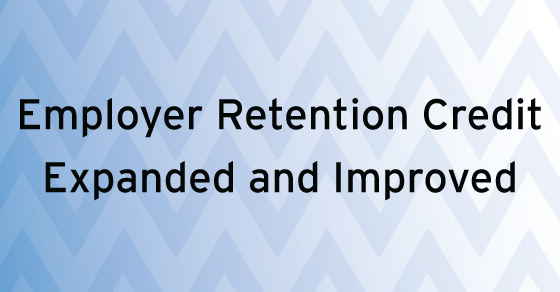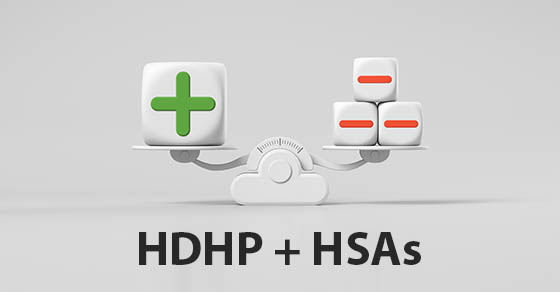January 25, 2021
The recently signed Consolidated Appropriations Act, 2021 (CCA) provides taxpayers much needed relief in many different areas. Everyone has heard about the additional $600 stimulus payment and the new round of Paycheck Protection Program (PPP) loans for small businesses. This article will focus on the Employer Retention Credit (ERC).
The ERC is a refundable payroll tax credit that was originally enacted as part of the CARES Act in March of 2020. For 2020, it is available to employers that either had 1) their business fully or partially suspended during at least one quarter in 2020 OR 2) had 50% reduction in gross receipts for a 2020 quarter when compared to the same quarter in 2019. The business remains eligible for the ERC until the end of the quarter in which the gross receipts have returned to at least 80% of what they were for the same quarter in 2019.
Generally, a business that qualifies under the 50% reduction in gross receipts test, may be eligible for a larger credit. When a business claims the ERC based on their business being fully or partially closed, qualified wages are limited to amounts paid during the period of shut down. However, under the reduction in gross receipts test, all qualified wages paid during a qualified quarter are eligible for the ERC.
In situations where there is an affiliated group of commonly owned businesses, aggregation rules apply. Aggregated employers are treated as a single employer for purposes of the reduction in gross receipts test to claim the ERC.
The ERC for 2020 is calculated based on 50% of qualified wages paid after March 12, 2020, up to a maximum of $10,000 per employee for the entire year. Once the employee reaches $10,000 in qualified wages, the credit on that employee is no longer available. Thus, the maximum credit per employee is $5,000.
What are qualified wages you ask? Well, that depends on whether the employer has 100 or less average monthly full-time employees (FTEs) defined as averaging at least 30 hours of service per week or 130 per month) or more than 100 average FTEs. If you have 100 or less average monthly FTEs, then you can use all wages (up to 10K per) paid to employees (whether the wages were paid to the employee for work performed or not). However, if the employer has more than 100 average monthly FTEs then only wages paid to employees NOT to work can be considered qualified wages.
Under the CARES Act, a business had the option of accepting a Paycheck Protection Loan OR claiming the ERC. Businesses were forced to choose one or the other. For those that chose the PPP loan, the ERC was not available, at least until the CCA was enacted in late December. Under the new rules, even if a business received a PPP loan in 2020, it may RETROACTIVELY go back and claim ERC for any eligible quarters of 2020. The caveat to this is that you cannot use the same wages used for PPP forgiveness to claim the ERC, so the allocation of wages between PPP and ERC can get a bit involved, depending on your payroll records.
While the CCA allowed PPP borrowers to retroactively claim the ERC, it did nothing to change the actual credit calculation for 2020 that was in effect with its original implementation through the CARES Act. The CCA just changed the law so that PPP recipients are eligible to take the credits, subject to PPP/ERC wage limitations for 2020. This ERC can be claimed for 2020 by PPP borrowers by amending the applicable Form 941 returns for 2020. Your payroll provider will play a key role in this process.
CHANGES TO ERC FOR 2021
While the CCA did not change the rules for calculating the ERC for 2020, it did extend the ERC through June 30, 2021 and made it more generous for 2021 than the 2020 version.
First, the gross receipt test for eligibility for the ERC in 2021 is reduced from 50% reduction to a 20% reduction when comparing gross receipts. To determine eligibility for Q1 2021 and Q2 2021, you would compare the receipts for the 2021 quarter to the same quarter in 2019 (Q1 2019 and Q2 2019 respectively). If the 2021 quarter gross receipts were at least 20% less than the corresponding quarter for 2019 that would represent an eligible quarter for purposes of ERC.
A special rule exists for 2021 eligibility where a business has the option to elect to satisfy the gross receipts test by looking at the immediately preceding quarter and comparing that quarter to the corresponding quarter in 2019. For example, in determining ERC eligibility for Q1 2021, a business could compare its gross receipts for Q4 2020 with Q4 2019 and if there was a more than 20% reduction, then Q1 2021 would qualify as an eligible quarter for ERC.
The ERC also is increased for 2021 from 50% to 70% of qualified wages and increases the annual $10,000 per employee limit to a quarterly $10,000 per employee limit. This means that a business qualified for the ERC for both quarters of 2021 could receive up to a $14,000 per employee credit assuming the same employee had at least $10,000 in qualified wages for both Q1 2021 and Q2 2021.
If you recall, qualified wages under the rules in place for 2020 year, depended in part on the size of the employer. If the employer had more than 100 FTEs, then only wages paid to employees that were not working were considered qualified wages. Whereas, for employers with less than 100 FTEs all wages paid for working or not, were considered qualified. The new law increases the 100 FTEs threshold to 500 FTEs, thus making it easier for more businesses to have qualified wages regardless of whether the employees were performing services or being paid not to perform services.
The Act also provides an “advance payment” mechanism that would allow employers with less than 500 FTEs to receive an advance payment of ERC. This amount would be based on 70% of the average quarterly wages of the employer for 2019. So, if a qualified employer’s average quarterly wages for 2019 were $100,000 the business could be eligible for an advance credit of up to $70,000. This essentially assumes that all wages are qualified. Any advance credit would be reconciled at the end of the quarter and any shortfall would be made up on future returns. There is very little guidance on the mechanics of the advance option, and we are awaiting details as to how this would apply on a practical basis.
As you can see, if a business is qualified for the ERC for either 2019 or 2020, it could provide a significant amount of tax credits to an employer. There is a bit of work to sort through the options and determine how much of an ERC credit is available, but it is certainly something worth considering for your business. The first course of action is to review your businesses quarterly gross receipts for 2019 and 2020 and see if you might be eligible. This will help you make a preliminary determination of your eligibility based on the substantial reduction of gross receipts test.
If you have any questions concerning the ERC, please reach out to your Maillie LLP representative for further guidance.





